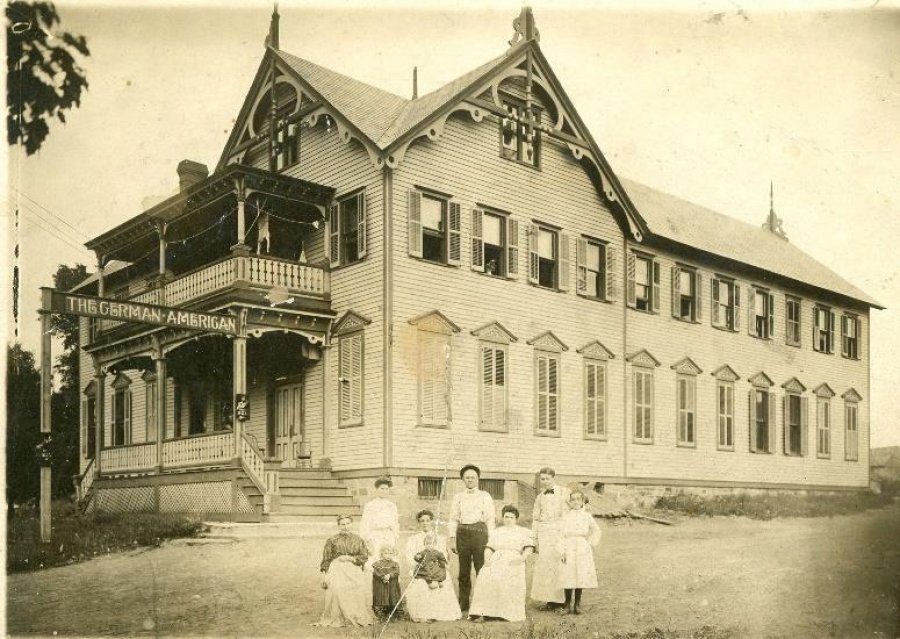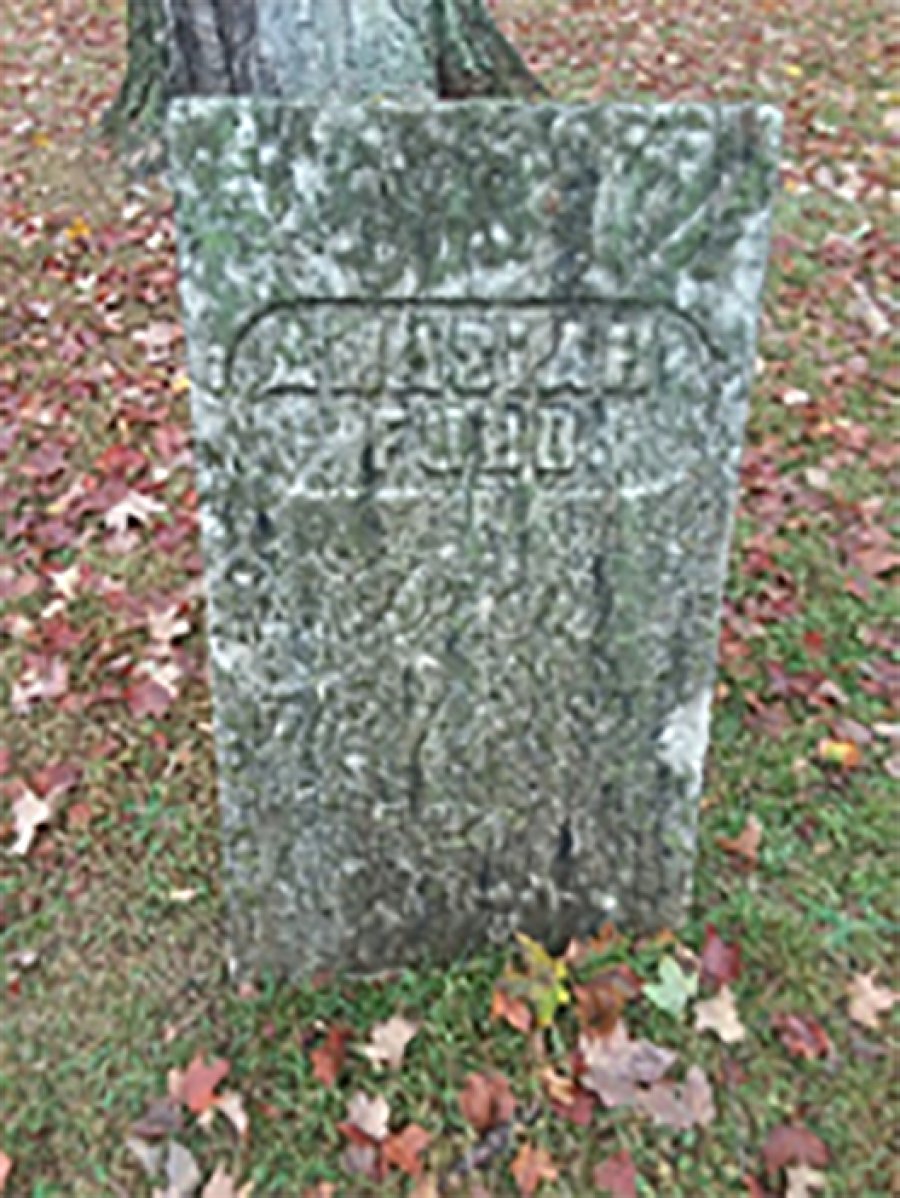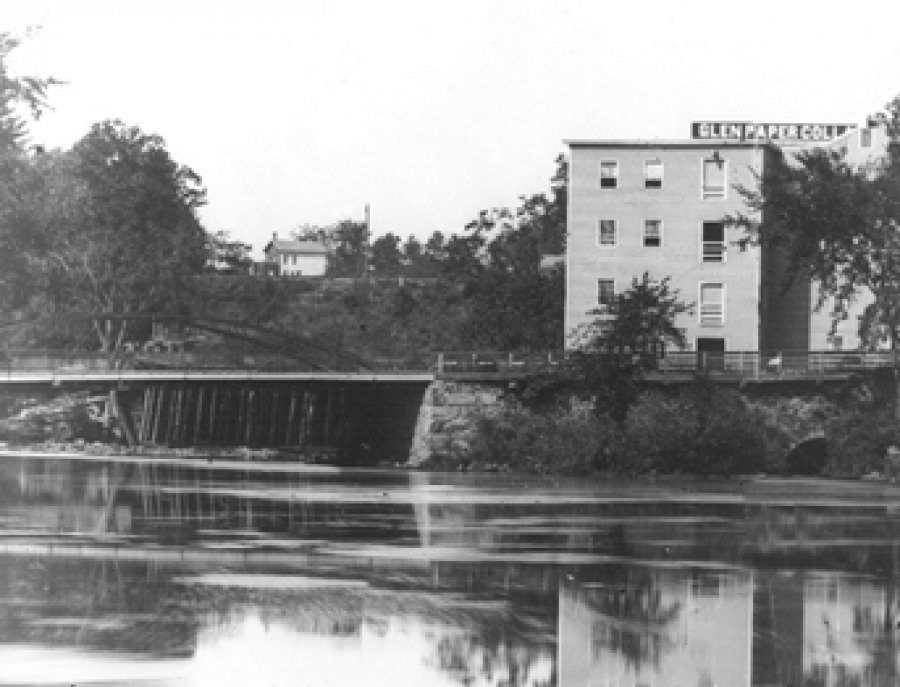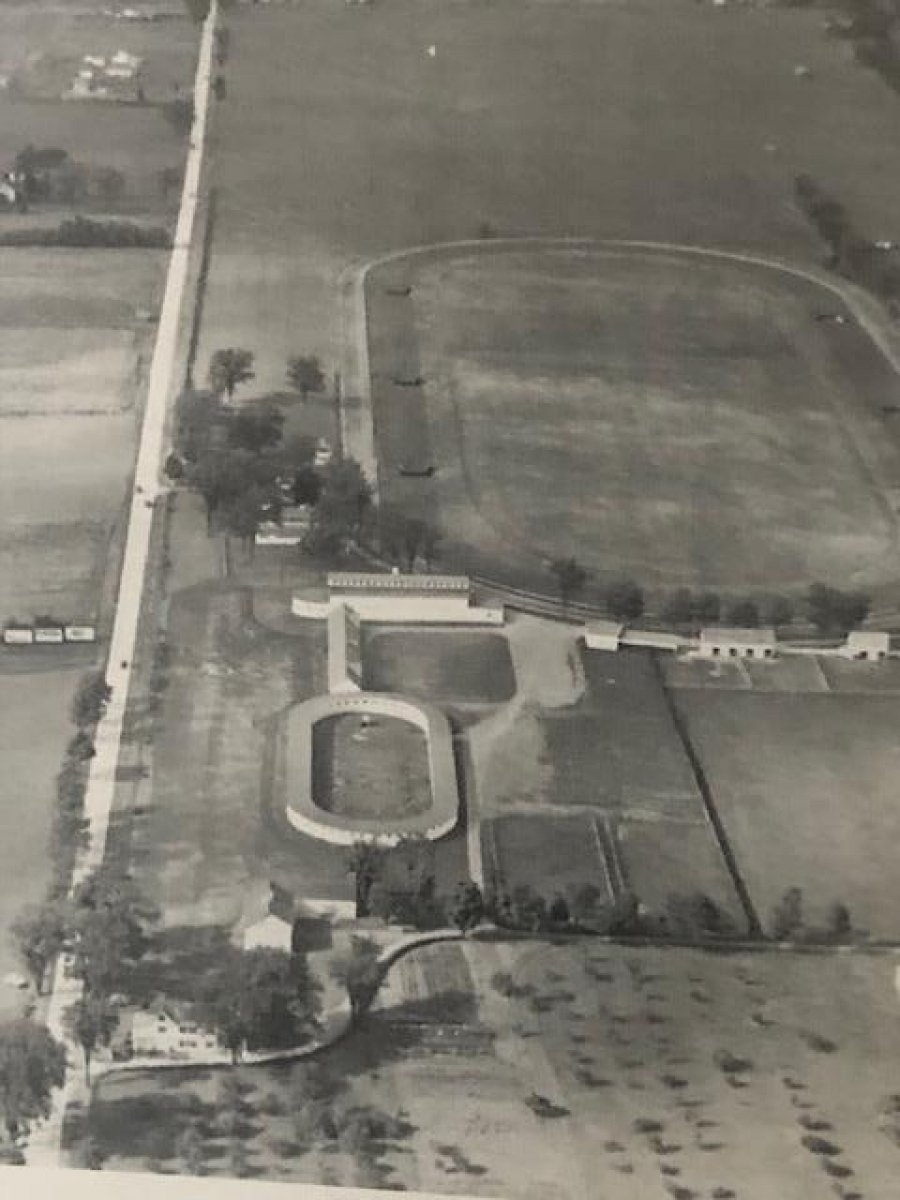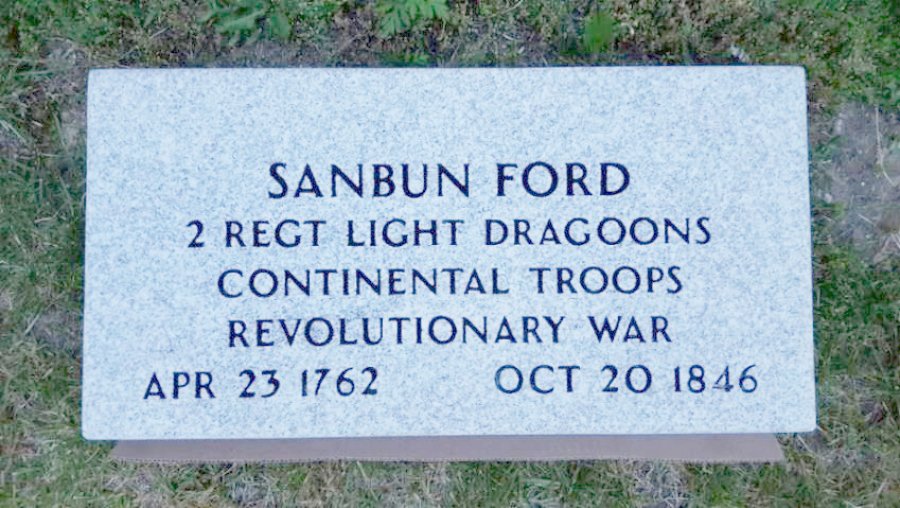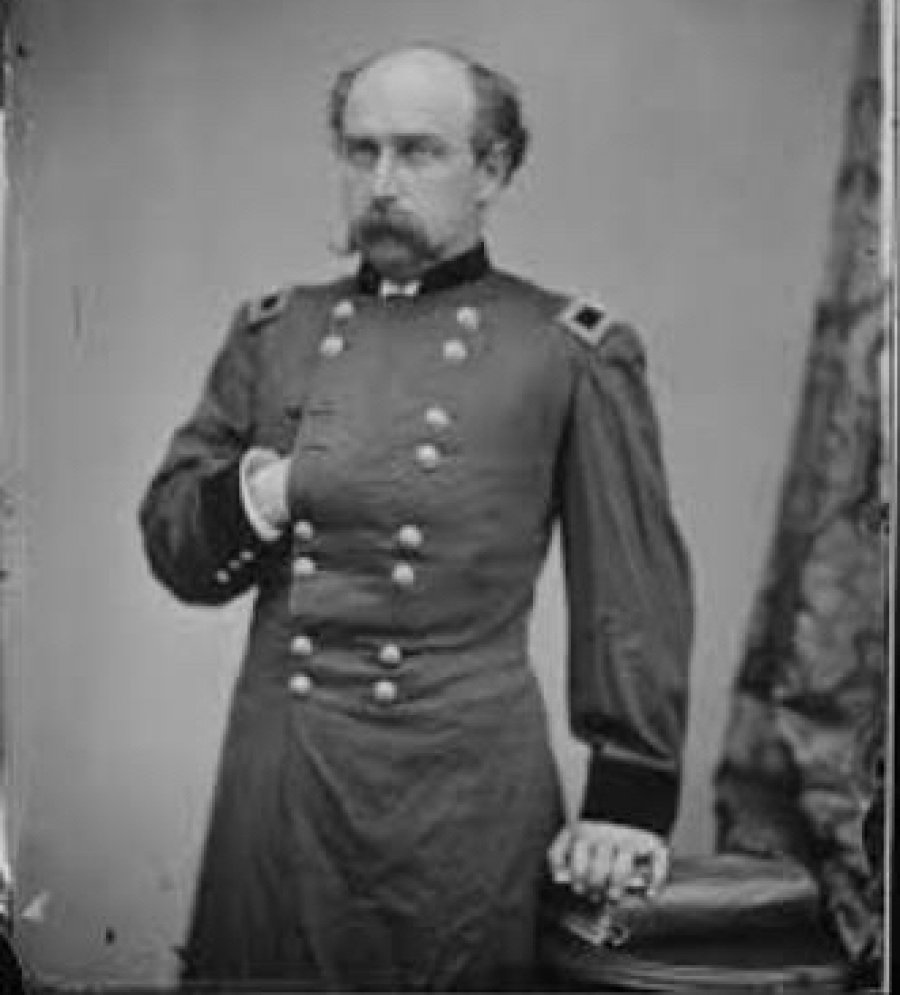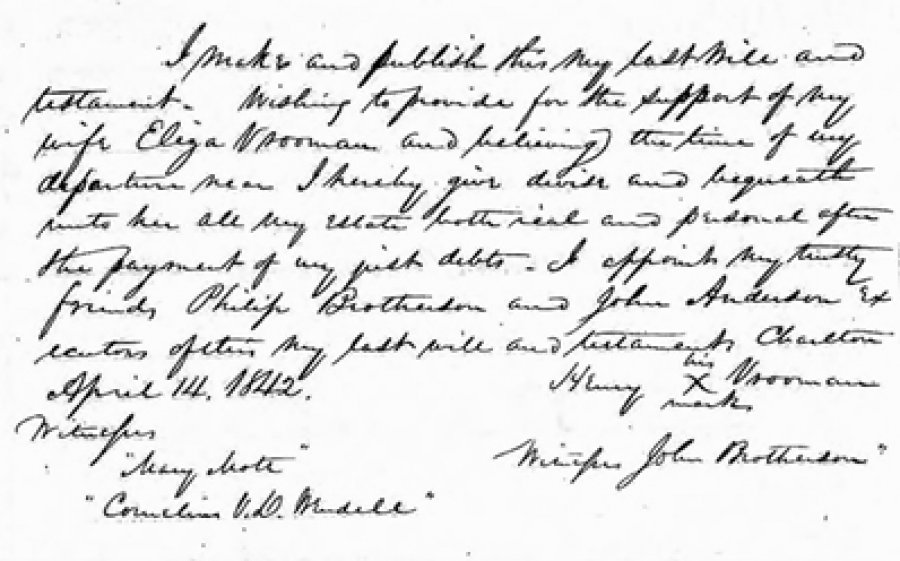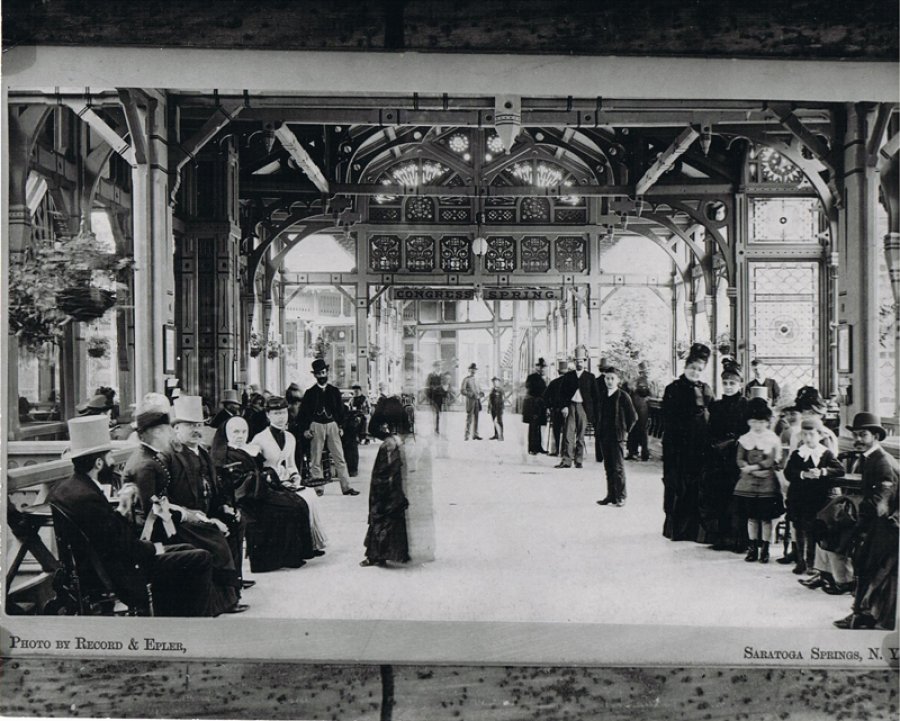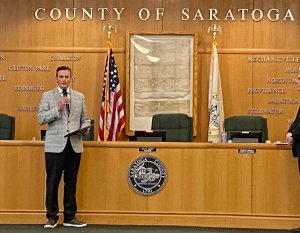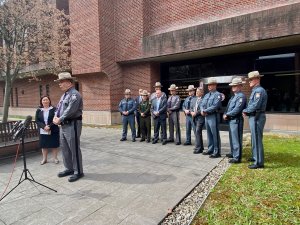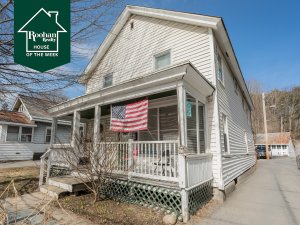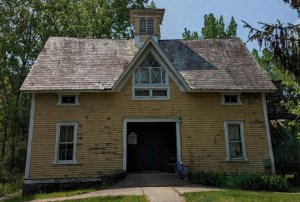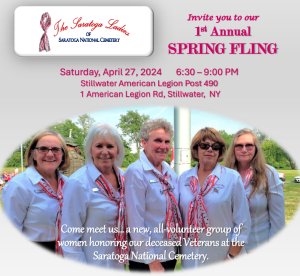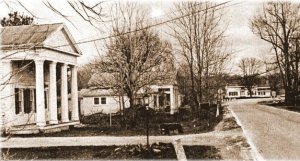Displaying items by tag: history of saratoga
Corinth German - American Club Fire
In the early morning hours of July 4, 1919, a fire alarm was sounded in the village of Corinth. Many residents believed it to be some boys celebrating Independence Day a bit early. However, when the International Paper Mill fire whistle sounded everyone knew it was not a prank. The popular German-American Club on Pine Street was ablaze. The local fire companies fought the fire and kept it from spreading to other buildings, but the large clubhouse could not be saved.
The German-American Club was constructed about 1890 on lower Pine Street next to a creek. Many German immigrants had come to Corinth to work in the Hudson River Pulp and Paper Company, (which became part of International Paper Company in 1898), in the last quarter of the nineteenth century. Settling along Pine Street near the mill, the Germans created a stock company that provided health insurance for their members as well as establishing the club house. The three-story wooden structure housed an opera hall, bowling alleys, billiard parlor, basketball court as well as rooms to rent. It became the social center of the community – picnics were held on the spacious lawn under the nearby pines.
In 1896 dancing instructions were offered with both stage and ball room lessons given on Monday afternoons and evenings. Participants could ride an omnibus to and from the club house. Bowling and shooting matches were held here, too, with prizes ranging from oil painting to boxes of cigars and beer. Both a Germania Glee Club and Germania Quartet gave grand concerts. Other community organizations used the club house for events including the Republican Party which had a grand rally here in support of William McKinley. The local fire companies held dances and festivals at the club house, too.
The property was later acquired by Pat Brady and by the time of the fire Edward Flynn owned it with William Flynn managing it. By 1914 it was known as the G.A.Club House since Germans were becoming unpopular leading up to the First World War. The Irish immigrants that lived on nearby lower Palmer Avenue (known as Cork Town) frequented the club house where Fitzgerald’s Famous ale and lager were on tap.
In November 1917 John Flynn was arrested for serving two men who claimed they were looking for work at the paper mill. The men asked for something to drink and were given “near beer.” When they asked for something stronger, they were provided with liquor. At that point the two men identified themselves as state troopers. Flynn was arrested and charged with a violation of the liquor tax law of New York.
On the evening before the fire William Flynn had locked up the empty building before going to Glens Falls Hospital to be with his wife and sick infant. It was suspected the fire had begun in the stock room from a defective electric wire and spread to the rest of the building. The loss was estimated at about $15,000 and there was some insurance coverage. The fire showed the community that new fire fighting equipment was needed and a new system to alert the volunteer hose companies had to be created.
Rachel Clothier is historian for the Town of Corinth, operates the Corinth Museum, and is retired from Crandall Public Library in Glens Falls.
Amasiah Ford: A Veteran of the War of 1812 who Fell on Hard Times
In 1845, Amasiah Ford, of Ballston Spa, wrote a multi-page manuscript for his application seeking a veteran’s pension. The account of his military experience 30-plus years earlier would be used 150 years later as references in several books on the War of 1812.
Amasiah was born on June 24, 1796, the third son of Revolutionary War veteran Sanbun Ford and his wife Ada. While farming was certainly a part of his early life in Saratoga County, at the age of 16 he enlisted in the U.S. Army at the outbreak of hostilities with Britain in 1812. Like his patriot father before him, Amasiah answered the call to arms to defend America at an early age.
He would see action at places such as Fort George, Ontario; Sackets Harbor, N.Y.; Chippawa Creek, Ontario and Lundy’s Lane, Ontario. At Lundy’s Lane (on the Canadian side of Niagara Falls) he noted that he was advancing with comrades when the British rose up and ambushed his company. Amasiah was one of just eight U.S. soldiers to escape the slaughter. He recounted how during another action he leveled his gun at an enemy soldier and they both discharged their guns at the same time. A musket ball passed through Amasiah’s cap under his cockade and he never saw that soldier again.
Amasiah’s pension records reflect forced marches in cold and inclement weather with little or no protection from the elements. In some spots, the soldiers were in mud up their knees. Another account relates how they had no food, but the officers procured a cow which was shared by all. With no bread to eat, they roasted pumpkins as a substitute.
His wartime deprivations while on campaign would be one of the main reasons why Amasiah sought a pension from the federal government. He stated that those years in which he served his country ended up giving him rheumatism which stopped him from working in his trade as a shoemaker. Two physicians from Ballston Spa would attest to this affliction.
Amasiah stated in pension papers for his older brother Simeon that they saw each other at Fort George in Upper Canada (Ontario) in June of 1813. Their paths crossed again in January of 1814 at Shadagee Four Corners, now present day Chateaugay, N.Y and finally in Plattsburgh, N.Y. in April of the same year. What joy there must have been at each of these encounters so far from home.
With his war years behind him, Amasiah met and married Selina Whitford July 4, 1818. They would have three boys and a girl. None would live past the age of 11, his second son dying in 1829 followed by his only daughter and youngest son in 1830. In 1831, his oldest child, 11-year-old Sanborn, was killed by a horse-drawn gig near the Sans Souci Hotel in the village of Ballston Spa. He would sue Col. James Monroe (nephew of President James Monroe), whose servant was driving the gig, and win a settlement of $200.
Amasiah’s older brother Simeon would name his youngest son, my great-great-grandfather, Sanborn. Was it to honor his brother’s loss?
In May of 1843, Amasiah was indicted for conspiring to defraud. Amasiah, along with Samuel Welden and Benjamin Howd, had conspired to defraud William P. Green by falsely reporting lawsuits before the justice of the peace in both Malta and Clifton Park. They were charged with procuring the issuance of a summons against Green and had Howd, a Clifton Park constable, serve the papers to a person impersonating Green. They later would get a judgment in default when the real Green didn’t show up. The evidence against Amasiah and Welden was so compelling they were both sentenced to three months in county jail and fined $250 each. Howd escaped judgement because it wasn’t clear if he was a willing participant or a duped official like the two town justices.
Amasiah died 13 days before his 57th birthday on June 11, 1853 and is buried in the Ballston Spa village cemetery next to his son Sanborn. He would reach out across time and establish his legacy by the pension papers he wrote over 175 years ago. His widow Selina received half of Amasiah’s pension after attesting to having run herself down taking care of her husband. Selina would live out her life with her sister and brother-in-law in Henrietta, just outside Rochester, N.Y. There she would join her husband and children, reunited for eternity, on February 11, 1873.
Prominent Sons, Prolific Inventors
Although no trace remains today, the Glen Paper Collar Company was a visible presence in Ballston Spa 150 years ago. It was located in the famous Blue Mill building on the north side of Milton Avenue, built as one of the area’s first grist mills. Many may have heard of the collar company, which was one of the largest of its kind in the country. But few know that the company’s owners, Horace Medbery and Henry Mann, were also prolific inventors.
Horace Medbery was the son of Stephen and Sarah Medbery, proprietors of the hotel in Ballston Spa which still bears their name. He was one of those rare individuals who was able to put his inventions to practical use in his various business ventures in Ballston Spa, Mechanicville, and elsewhere. Henry Mann was the son of Henry Mann Sr., a prominent local businessman and Saratoga County treasurer. The Mann family lived in the former Aldridge’s Hotel, now the home of Brookside Museum, just down the street from The Medbery Hotel. Horace and Henry were neighbors while growing up in the village.
During the 1870s, a peculiar clothing fad swept the country. Disposable cotton-based paper collars were introduced to the upper classes as a way of maintaining a fresh, white collar rather than attempting to clean soiled cloth collars. Some of the first paper collars in the country were manufactured two miles north of Ballston by Lindley Murray Crane, a paper mill owner and holder of three patents. Henry Mann’s father also manufactured paper collar materials in nearby Factory Village for some years under the partnership of Mann & Laflin.
Horace and Henry recognized their business opportunity even before the fad hit its peak, and rented space at the Blue Mill to establish the Glen Paper Collar Company. In their first year, the partnership produced nine million collars. Profits were poured back into the business by purchasing the glazing works of Rand & Edwards located below them in the Blue Mill. Soon they occupied the entire building, so in 1871 they were forced to build a five-story, 60 foot by 40 foot addition, reportedly constructed in twenty days. They rented the old Waverly Hall for use as a packing station and salesroom.
Shipments of collars increased year after year. At its height in 1875, the factory was producing 21 million paper collars and five million paper cuffs per year and employed 150 people.
At this time, Medbery submitted his first of many patents. He, along with Henry Mann and Simeon Drake, perfected a new steam drying wheel for use in the collar factory. The machine was developed, as the partners put it, “after much study and reflection, and expenditure of money in purchasing machinery which did not meet our wants.”
On the same day as the drying wheel patent was filed, Medbery submitted an improvement for cutting paper collars, the object of which was to rapidly cut collars from long rolls of cloth-faced paper by passing it between two rollers. One of Ballston’s more unusual inventions was developed by Henry Mann, who patented a shipping box for paper collars that could be converted into an ornamental lampshade.
The three patents listed above would be the only inventions that related to the Glen Paper Collar Company. Despite becoming one of the largest paper collar companies in the world, the fad died out in the mid-1870s, forcing the partners to shut down the collar factory. Henry Mann went on to invent and patent an envelope-making machine. Local inventor Samuel Day constructed nine of the machines which were set up in the Blue Mill. The Mann Envelope Company operated for several years before closing down for unknown reasons.
In 1879 Horace Medbery moved to Mechanicville and rented the Howland Paper Mill, operating it for three years before organizing the Hudson River Water Power & Paper Company. He erected an 800 foot-long dam across the Hudson River using an estimated 3.5 million bricks. In this endeavor, Medbery is credited with establishing a valuable new industry for the city. Other businessmen noticed the success of his project, and soon permanent brick yards were established such as the Mechanicville Brick Company and the Best Brick Company.
For the next four years, Medbery acted as secretary and general manager of the paper mill. During that time, he patented two machines for molding tubes from paper pulp. In 1891 he patented a conduit for underground trolley wire using material that he claimed was water-proof, gas-proof, and “practically indestructible.” Later that year he submitted a patent for a pail-making machine, which manufactured pails using paper pulp. There is a reference in Sylvester’s History of Saratoga County that the Glen Paper Collar Company produced and sold these pails, so this patent is very likely based on that endeavor.
Over the next few years Medbery put several more of his inventions to good use. In 1892 he established the Fiberite Company, which manufactured fiber pipes for interior conduits used to wire buildings. The technology he developed in his seamless tube patents no doubt was applied to this line of work. He also began producing fiber pails using his pail-making machine, and later developed a substitute for hard rubber and celluloid. Medbery will go down in history as possessing more 19th century patents than any other Ballston native.
Walking the Horses to Saratoga
Born in 1826, Stephen Sanford worked with his father John and then on his own to create the Sanford carpet mills in Amsterdam. He went to West Point, served in Congress and was a friend of Ulysses S. Grant.
In the early twentieth century, thoroughbred horses owned by Sanford were walked each summer to Saratoga from Sanford’s Hurricana Farm. Racing Hall of Fame trainer Hollie Hughes, who served three generations of Sanfords, recalled the annual trek in Alex M. Robb’s book, “The Sanfords of Amsterdam.”
The trip began at the Sanford horse farm on what is now Route 30 in the town of Amsterdam. Efforts are underway to preserve remaining buildings at the complex, originally called Hurricana Farm but later known as the Sanford Stud Farm.
“First, we’d go up to Hagaman, a couple of miles away, and then we’d head for Top Notch, or West Galway, as it’s called,” Hughes said. “That would be about five miles. Then we’d go three miles straight east to Galway village. Then we’d go to West Milton, about seven miles farther east, and there we’d stop at the old Dutch Inn and feed the horses and men. My, those breakfasts tasted good! By that time, it would be close to daylight. On the way over, half the horses would be under saddle with boys up. After breakfast the saddles were put on the others which had been led by the men up to this point, and we’d walk the remaining ten miles to Saratoga, coming in by Geyser Spring.”
In 1901, Sanford built his own stable on Nelson Avenue in Saratoga. He had as many as 35 horses at a time. When asked why he kept so many horses, the industrialist replied he was not in the horse racing business for “margin,” in other words for profit.
From 1903 through 1907, the Sanfords invited the people of Amsterdam to the Sanford Matinee Races at Hurricana on the Sunday closest to Fourth of July. Trolleys ran continuously up to Market and Meadow Streets. From there, horse drawn wagons took people to the farm. Some automobiles went to the farm as well but were not admitted to the grounds. There was food, drink, music and, of course, horse racing. Some 15,000 attended the event during its last year.
New York State outlawed betting in 1907 and racing stopped at Saratoga. Temporarily, the Sanfords sold most of their horses to out-of-staters and Canadians, according to Robb.
Stephen Sanford was blind the last five years of his life. The old gentleman doted on his grandchildren, in particular his namesake, born in 1899. He gave the boy a Shetland pony almost before the youngster could walk. Young Stephen called the pony Laddie. The grandfather bestowed the nickname Laddie on his grandson as well. Sanford died on February 13, 1913. Six months later, racing resumed at Saratoga along with the first running of the Sanford Memorial.
Stephen’s 62-year-old son John continued to head the carpet mills and racing stables created during his father’s lifetime. According to Robb, John Sanford inherited $40 million at his father’s death.
Robb wrote, “Hollie Hughes recalls Stephen Sanford as a man with a magnetic personality, one to whom your eyes would turn instinctively, even though he was but one of a hundred men in a crowd. Hollie describes him as tall, thin, straight as a ramrod, his chin (and the chin whiskers) carried high, his right arm across his back. He had a dry wit.”
Bob Cudmore writes the weekly Focus on History column for the Daily Gazette. He is author of three Amsterdam area history books: Lost Mohawk Valley, Hidden History and Stories from the Mohawk Valley. Bob is the host of The Historians, a weekly podcast heard online at www.bobcudmore.com and on several area radio stations. He lives in Glenville and is a native of Amsterdam.
A version of this story first appeared in the Daily Gazette.
Sanbun Ford: Forgotten Patriot Rediscovered
In 1976, as the nation prepared to celebrate its 200th birthday, my parents, Joan and W. Donald Carola of Mechanicville, were already a year into the hunt for records of an elusive ancestor: Sanbun Ford, a founder of the town of Milton.
Trips to local court houses and towns in New England resulted in a Ford family genealogy story, dating back to 1637, that they presented to my mother’s father, Joseph Ford, a retired paper mill electrician from Mechanicville. In 1976, he was invited to Milton’s Founders Day celebration where he and other descendants of the town’s early settlers were welcomed as guests of honor.
Through my parents’ long-ago sleuthing and my own research, our family has learned much more about Sanbun Ford. He was born on April 23, 1762 in Wallingford, CT, the fifth-generation Ford descended from Timothy Ford, an Englishman who arrived in New England circa 1637.
On Dec. 4, 1779, Sanbun enlisted as a private in the 2nd Continental Light Dragoons, known as Sheldon’s Horse for its commander, Col. Elisha Sheldon. There are indications that he joined the Patriot cause to replace a sick older brother. Sanbun would serve five-and-half years with the unit. Nathaniel Bartlett Sylvester’s “History of Saratoga County, New York” has a paragraph describing Sanbun as having served from Bunker Hill to Yorktown, but I’m still working on verifying details of his service.
Sylvester’s book also mentions that Sanbun once captured a “cowboy” by making him place his finger into the barrel of Sanbun’s pistol. Cowboy was the name given to Loyalists who attacked residents and stole livestock and personal possessions in Westchester County, which during the Revolutionary War was the scene of vicious partisan fighting.
We know from Sanbun’s military pension papers, dated June 1837, that he captured a notorious cowboy named Jesse Mills, who was among the 450 Westchester Loyalists sent on two ships to Saint John, New Brunswick in Canada after the war.
A roster of Sanbun’s regiment compiled by Maj. Benjamin Tallmadge shows that he was 5 feet, 3 inches tall with light complexion, gray eyes and brown hair. Like many American veterans of the war, Sanbun was given land by Congress for his service. In 1790, he and his wife, Ada, and their first child, Simeon, settled in Hillsdale in Columbia County, NY.
Two years later, they moved to Milton in Saratoga County. Together, Sanbun and Ada raised nine children, four boys and five girls. At least two sons would fight in the War of 1812. The daughters would go on to marry men with last names Hall, Shepard, McLean, Irish and Lewis.
Grandsons of Sanbun and Ada would fight in the Civil War. Their names can be found on the Civil War monument located at Low and Front streets in the village of Ballston Spa. There is a street named after the Fords, many of whom are buried in the Village Cemetery in Ballston Spa. Later generations of Fords branched out to Mechanicville and Green Island. Others ended up in western New York.
Various documents note that Sanbun settled at Spiers Corners, now West Milton, and later ran a public house near the Rosehill farm of Judge John Thompson where aging fellow Patriots came to dine and reminisce about their wartime service. During the War of 1812, after U.S. victories, Sanbun and the Rev. Elder Langworthy would fire off a cannon they had purchased in Albany.
By 1820, Sanbun was destitute and penniless, living off his Revolutionary War pension and the generosity of fellow members of the local Baptist church. Employed to ring the church bell, he eventually had to give up that duty due to poor eyesight. A religious man, Sanbun called his Bible his side-arm.
Sanbun died at 84 years old on Oct. 20, 1846, a year-and-a-half after his beloved wife Ada. Before he died, he asked that an American flag, his Bible and Continental Army papers be buried with him.
Sanbun was buried in an unmarked grave in the Village Cemetery. A chance meeting with cemetery caretaker Rich Fox led me to the location of the Ford plots. I then went to work acquiring a veteran’s grave marker from the U.S. Department of Veterans Affairs.
The marker was placed on Sanbun’s grave just prior to July 4, 2017. Every Fourth of July, I place two American flags on his final resting place as a tribute to a Patriot once forgotten, now remembered.
Don Carola is a local history buff who was born and raised in Mechanicville. He retired from the state after 33 years from NYSITS as Manager of Information Technology. Don is a volunteer firefighter for Hillcrest Fire Department. He is also a member of Rev War reenactor unit 2nd Continental Light Dragoons “Sheldon’s Horse” out of Connecticut. Don can be reached at This email address is being protected from spambots. You need JavaScript enabled to view it.
Egbert Ludovicus Viele - Engineer, Soldier, Politician
Egbert Ludovicus Viele died on April 22, 1902 at the age of 77 in New York City after an eventful life that began in Waterford, New York. He was born in 1825, son of Kathlyne Schuyler (Knickerboacker) and State Senator John L. Viele. The title of his newspaper obituary notice “Veteran of Two Wars and Indian Campaigns Passes Away” did little justice to his varied career, nor his personal foibles.
Egbert attended Albany Academy and on July 1, 1847, graduated from West Point and was appointed 2nd Lt. of the infantry and served in the Mexican War. From there he was sent to Laredo Texas, became the Military Governor and conducted successful campaigns against the Indians on the western frontier. By October 1850 he was promoted to 1st Lt. but in 1853 he resigned from the military.
Viele moved to New York City and became the State Engineer for New Jersey, 1854 - 1856. In 1856 he was appointed engineer-in-chief of Central Park and in 1860 redesigned both Central Park and Prospect Park. When the Civil War began he rejoined the military on the Union Side. He became engineering officer of the Seventh Regiment, and was commissioned Brigadier General of Volunteers August 17, 1861
General Viele marched to Washington, forcing the cross of the Potomac River, leading the first troops to reach the capital by that route. He commanded brigades during the Union assaults on the Confederate forces along the southeast coast, first at Port Royal in November 1861, and then the victorious attack on Fort Pulaski on the Savannah River the following April. He participated in the capture of Norfolk, Va., and was named Military Governor of that area later in 1862.
He resigned from the service on October 20,1863 to again follow his career in civil engineering. Moving back to New York City he composed the “Viele Map”, a survey of the original streams and coastline superimposed on the streets of Manhattan, still in use today. 1866 he became a Companion of the New York Commandery of the Military Order of the Loyal Legion of the United States. In 1867, he worked as chief engineer on the Pittsburgh, Buffalo, and Rochester Railroad.
From 1883 to 1884 Viele was the commissioner of parks for New York City. He was elected as a Democrat to the Forty-ninth Congress (1885 – 1887) but was an unsuccessful candidate for re-election in 1886 to the Fiftieth Congress. Egbert resumed his former business pursuits and engaged in literary work.
Viele died from a “sudden attack of indigestion and heart disease” at the age of 77 in New York. He and his second wife, Juliette Dana, are entombed in a pyramid-shaped mausoleum, guarded by a pair of sphinxes, in the Post Cemetery at West Point, New York. Egbert had a buzzer installed in his coffin wired to the house of the Superintendent of West Point to provide rescue if he had accidentally been buried alive.
His father owned mills in Cohoes. Although undocumented, one can assume he must have returned to Waterford to visit family over the years.
Russ Vandervoort in the Waterford Town Historian and leader of the Waterford Canal and Towpath Society and can be reached at This email address is being protected from spambots. You need JavaScript enabled to view it.
The Short but Eventful Marriage of Henry and Eliza Vrooman
On April 15, 1842, Henry A. Vrooman, a forty-one-year-old farmer living in West Charlton passed away in his home near the intersection of what is now Eastern Avenue and Sacandaga Road.. He was laid to rest in the nearby West Glenville Cemetery. Only eight months earlier he had married forty-year-old Eliza McClelland, a widow with two children from nearby Blue Corners on the western edge of the Town of Charlton. It was a roller-coaster eight months.
Only a few months after their marriage, Henry’s new bride packed her belongings in a sleigh and left just before their first Christmas together. Henry started telling friends that he did not want her to return. However, calling it just a family visit, Eliza was back after only a month.
During the winter, Henry became ill. Dr. David Low, the attending physician, informed him that his case was “perfectly hopeless” and that he should make arrangements for the disposition of his property. The day before he died, Henry Vrooman asked his brother-in-law, attorney John Brotherson, to take down his will where he gave everything to his wife Eliza. Others present that day was his cousin Cornelius V. D. Wendell, Eliza’s friend Mary Mott, and Henry’s brother John.
After the will was placed in the hands of the Surrogate Court, Henry’s brother requested an investigation to prove its validity. Though present when his brother had spoken his will, John had been sick and in bed on the other side of the room, unable to hear his brother’s whispered words.
Two months after Henry died this proceeding was held in Surrogate Court , with those who had witnessed the signing of the will and other interested parties attending and giving testimony. They were all to offer different perspectives on the short marriage of Henry and Eliza.
The first to testify was Henry’s cousin, Cornelius V. D. Wendell. After being sworn in, Cornelius said that he was present when Henry Vrooman made known his desires about the distribution of his property and “made his mark,” to sign the document.
The next to give testimony was Mary Mott, Eliza’s friend and neighbor of her father. Before her marriage to Henry, Eliza had lived with Mary and her husband. Mary gave a woman’s perspective in her words of support for her friend:
Know there were some difficulties between the deceased and his wife but what they were I can’t tell anything about. Deceased told me that his brother John W. caused a great deal of difficulty between himself & his wife. He went so far as to say that there never would have been any difficulty between himself & wife if it had not been for his brother. He told me that his brother said that he did not like it that he should get married. He told me once that his brother had behaved so badly to him that he did not intend he should ever have a cent of his property.
When it was John Brotherson’s turn he stated that when the will was made, Henry was asked if his brother should be called to sign as a witness to his will. His response was a (negative) shake of his head. When the will was read back to him, he said that it was as he wished it, and then he smiled.
Peter Saunders next offered the first testimony concerning the break in the relationship between Henry and Eliza. Saunders and Henry Moore had visited the Vrooman farm in early 1842 to purchase property that Henry and his brother owned in Glenville. When asked about having Eliza sign the deed, Henry then said she had left him and that she would never be back “as long as I have strength to keep her out.” He also stated that she was extravagant and would have more company than he could afford. Sanders also testified that Henry stated that she had abused him when he undertook to correct her children.
John Anderson was another neighbor who testified about Henry’s relationship with his brother John. Anderson was a close friend of Henry’s brother and had once been asked by him to help “settle a difficulty” between him and his brother after Henry and Eliza had married. Anderson also heard Henry say that his wife had gone away and that he “never wanted to see her in the house again, she or none of her tribe.”
But Elizabeth Odell, the daughter of Philip Brotherson’s second wife Alice told a different story. She recalled that it was Christmas week in 1841 that Eliza moved back to Blue Corners. Once Eliza had returned to Henry, Elizabeth visited and was told by Henry that he and Eliza “live as happily as two birds together.”
Next, Alletta, daughter of Philip Brotherson and his second wife Alice told of Eliza’s care of Henry during the final months of his life. During her visits to their home, she saw Eliza “nurse him, procure his victuals for him & take care of him as well as any baby.” Mary Mott in her testimony supported this claim, even telling that after the funeral John had said that he thought Eliza must be “very much fatigued as she had been very faithful & kind to my brother & had nursed him and taken good care of him during his sickness.”
The hearing ended with Henry’s will being admitted to probate and filed. Apparently, the judge sided with those that testified that the couple’s marriage had conformed to the old adage that “All is well that ends well.”
The source of material and illustration for this article is Saratoga County Wills, Volume 12, pages 425 through 449
Dave Waite has had a lifelong interest in New York State and Adirondack history. His research has been published by historical organizations across upstate New York. His most recent article “With Energy and Success, Thorp & Sprague’s Mohawk Valley Stage Line,” is featured in the Winter 2021 New York Archives Magazine. David’s email is This email address is being protected from spambots. You need JavaScript enabled to view it.
History of Saratoga - Congress Hall: Putnam’s Vision
The grand hotels of Saratoga Springs, in the 19th century, were the most visible indication that our city was the number one tourist destination in the country. The hotels were huge in size, eloquent in style and known throughout the country as “the place” to be in the summer season. Gideon Putnam built the first hotel in the village in 1802 and it was then known as Putnam’s Tavern and Boarding House. This initial hotel had the capacity to house 70 guests. In 1802 Saratoga Springs was not in need of large hotels because it was a small fledgling destination but as our popularity grew, it didn’t take long before Putnam needed an “overflow” for his first hotel and began to plan and build a new hotel. The new hotel would be called Congress Hall. The Congress would be located on the eastside of Broadway, stretching from the south-east corner of Spring Street to East Congress Street (the entry to Congress Park today).
Gideon Putnam began construction of Congress Hall in 1811 with the name coming from the nearby famed Congress Spring that was a well-known asset in the early village. While working on the north façade of the hotel, Gideon fell from the scaffolding and was seriously injured. Putnam suffered for months from those internal injuries until he died on December 1, 1812. Congress Hall was three stories tall with 196 feet of frontage on Broadway and two wings that went down Spring Street and East Congress Street for a length of sixty feet. The front side of the hotel had 17 columns each thirty feet in height that framed a very beautiful porch that gave guests a place to sit and observe the activity on Broadway day and night. For this period in Saratoga history the Congress was a very large hotel that had a capacity to accommodate 150 guests. Early ownership of the hotel preferred to make this destination a house of temperance and religious activity.
In 1814 the hotel waspurchased by Grandus Van Schoonhoven who worked on the property until 1815 to further match the original plans set forth by Putnam. At this point in city history the Congress Hall was the largest hotel in Saratoga Springs until the United States Hotel was constructed and opened in 1824. Van Schoonhoven was joined in business by his nephew in 1822 and then again joined by others in 1823. In general, the hotel was leased to many different proprietors during the period from 1823-1855. In 1819 the village of Saratoga Springs was declared a special township with the right to self-govern. In that year the town decided to allow certain “pleasures” to be introduced in the village. In the summer of 1819 the Congress Hall introduced billiard rooms, an orchestra for concerts at night and allowed men to play cards in their rooms. These new additions made Congress Hall a desired location for dancing and other flirtation activities of the day. In 1822 Frank Johnson, a prominent band leader, came to provide the music for the dances called “Saratoga Hops” that would continue for years as a much-anticipated event of each season.
After midnight on May 30, 1866 the original Congress Hall burned in a very rapidly spreading fire that also destroyed the nearby Hamilton Spring and Bath House. The management had been working to prepare for the Congress Hall to open for the summer season of 1866 on June 1st. The original hotel was constructed of wood and was very susceptible to catching fire from the many open flame devices used in that time. Henry Hathorn was the owner at the time of the fire and began to immediately make plans to re-build. The new hotel would be constructed of brick and be much larger and grander than the original.
The new larger Congress Hall would be rebuilt in 1868 and would extend 416 feet down Broadway with two right angle wings, 300 feet in length with a rear courtyard in the middle. The entrance to the hotel revealed a lobby with a grand staircase and 16-foot-high ceilings on the first floor. The piazza on the Broadway side was 20 feet in width that would hold countless rocking chairs for guests to rock away the summer days while fueling the gossip of the day. As the new Congress Hall was planned and constructed it was evident that the hotel needed a large ballroom to compete with the other larger hotels in Saratoga Springs. Property that was not part of the original footprint of the hotel needed to be purchased to allow for the ballroom. The needed property would be found on the north side of the intersection of Broadway and Spring Street. The building that would house the ballroom still stands today but is composed of retail on the first floor and condo housing on the floors above. Henry Hathorn connected the hotel to the ballroom with a convenient iron pedestrian bridge, made in Troy NY, that passed over Spring Street. This passage-way allowed women to maintain clean silk shoes and hems of long dresses during inclement weather as they walked above an unpaved Spring Street. The metal bridge was further dressed up with the addition of carpeting, Chinese lanterns and an awning used during rainy weather.
During the summer of 1869 the Congress Hall hotel was prepared to host the first suffrage convention with Susan B. Anthony in attendance. By 1873 the new ballroom allowed the hotel to offer many great forms of entertainment during the summer season featuring Friday night balls with famous orchestras and performers. A travel guide in 1874 defined the Congress Hotel as the spot for American aristocracy to spend their Saratoga summers, that offered no barriers to the mixing of average people to high society. It has been noted by some travel guides, and a few historical accounts, that many felt that during this time that the village of Saratoga Springs taught the average American how to take a refined, civilized vacation. Undoubtedly, Congress Hall provided a location and an atmosphere for that education. As the years went on and the city approached the 1900’s, Congress Hall began to fall from favor with the vacation crowds and went into bankruptcy on May 9, 1904.
Between the summers of 1904 and 1911 many attempts to re-open and re-organize Congress Hall eventually failed. Congress Hall was closed forever and sold to the City of Saratoga Springs in 1911 with demolition to follow. The land on which the hotel stood was added to expand Congress Park and was just a foreshadowing of the eventual demolition that would take down the other two giant hotels, the Grand Union and United States. Vacation styles in America were changing and so would Saratoga Springs as it continued to re-invent itself to remain the “summer place to be.”
History of Saratoga - Geology of the Mineral Springs
To truly understand the beginning of Saratoga Springs as a village you must understand the importance of the mineral springs in our development. A real understanding of the mineral springs is anchored in the understanding of the local geology.
Most people that visit the city today are not huge fans of the taste of the mineral springs when they try them for the first time. Having grown up in Saratoga Springs, my family and I always loved the taste of the springs, but I understand mineral water has a taste that you need to get accustomed to before saying you enjoy it, if ever. In 2019 some people say they only like the spring that dispenses water near the Auto Museum in the Spa State Park. That spring is not an example of a true deep sourced mineral spring in the city but rather a fresh water spring that draws its water from the upper hundred feet of another aquifer.
In order to better understand the deep sourced true mineral springs, we need look at the geologic history and therefore go back millions of years in Earth history. Approximately 490 million years ago the area around Saratoga looked very different than it does today. We were covered by a beautiful tropical ocean basin that became shallower as you traveled to the west toward Galway to eventually form the shoreline of this ocean and as you moved east toward Vermont it got deeper. Mountains further to the west were eroding with streams and rivers bringing sediment from that erosion process to the ocean for deposition. These deposited sediments would eventually harden to make varieties of sedimentary rock that would cover this entre area. Rock types like sandstone, limestone, dolomite, and shale were all deposited over millions of years in very thick layers in the Saratoga area. Most of these sedimentary rock types will hold rain water in their layers and act as a storage system or aquifer in the ground. The last layer to be deposited was a layer of black shale. Shale is a non-porous rock that will act as a protective cap over the other layers below.
This deposition process was stopped when the ocean receded as the area rose in elevation. Over millions of years as tectonic forces in the earth’s crust pushed on the rock layers it caused earthquakes to fracture those rock layers. Those fractures can be found as faults all around Saratoga. A very large fault called the McGregor Fault produced Mt. McGregor and continued south and branched to form the Saratoga Fault which is the main geologic fault running through the city that produced the mineral springs. The Saratoga Fault is categorized as a “normal” geologic fault. To understand a normal fault, picture a large block of material that is under pressure and breaks in the middle to produce two separate pieces. Then picture one of the two pieces rising and the other sinking down relative to the break or crack. This is the shape of a “normal” fault. Now picture Broadway in Saratoga Springs. The break or fault runs the length of the street. The break caused the west side including Broadway to rise and the east side to sink relative to each other. As a result, we see all the streets on the east side of Broadway such as Lake Avenue, Caroline Street, Phila and Spring Streets all go down in elevation from Broadway, therefore go down the face of the fault. This displacement is best seen in the rock cliff found in High Rock Park behind the 9/11 Memorial. Because of this fault all mineral springs are found on the east side of the fault.
This fault provided the break in the rock layers to allow the water trapped in those rock layers to rise to the surface as natural mineral springs. The Mohawk enjoyed the waters from these naturally occurring springs for hundreds of years before European settlers arrived with the technology to drill more mineral springs. By 1900 we had reached an apex in the number of springs in the city of Saratoga Springs with the number at 203. Many of these springs were pumped to extract carbon dioxide gas from the water for use in soda fountains in big cities. This abuse caused many of the original springs in the city to go dry. State laws passed in 1908 restricted the use and number of mineral springs to just 17 today. This restricted number allowed the aquifer over time to build back the necessary ground storage to provide for a stable supply for future use.
Many geologists today have wrestled with the analysis of why the mineral springs of Saratoga Springs are so unique. Our mineral springs are some of the highest naturally carbonated waters found in North American as well as some of the most highly mineralized “cold” water springs on the continent. The problem of carbonation has not been solved. The source of carbon dioxide gas is hotly debated but not resolved. Some claim the gas is from very deep-seated volcanic sources, while some think it’s a chemical process that provides it.
In the area of mineral content, we know heat helps to dissolve material in water as seen in cooking or in “hot springs.” Because our waters are cold and emerge from the ground at a consistent temperature of 52-54 degrees Fahrenheit year-round, that also presents a problem for discussion. While coming to the surface cold, the mineral water brings with it very large amounts of dissolved minerals from the ancient rock layers below. These minerals are what gives the Saratoga mineral springs their unique taste and possible health benefits. Our waters contain trace amounts of iron, iodine, cobalt, lithium, chromium, zinc, calcium and magnesium as well as many electrolytes. Our mineral waters do not contain sulfur in any reasonable amount and therefore cannot be identified as sulfur water.
Yes, our mineral water is unique and probably not in high demand because of its taste, but it helped to supply a need for visitors in the 1800’s. It was mineral water that acted as the spark that brought people to our city and helped it to become the number one resort in the United States in the 19th century.
History of Saratoga - Summer in Saratoga: 1874
A common publication in the 1800’s was the location specific travel guide, that would help visitors traveling to a particular location make the best use of their vacation time. As you can well image, Saratoga Springs had many such guides for visitors since we were a popular destination for summer visitors.
I find it interesting reading these guides because they give us a look back in time as to what was exciting and popular for visitors coming to the city. I recently searched the travel guide titled; “SARATOGA and What Is To Be Seen There.” This guide was written in 1874 by R.F. Dearborn M.D. and sold for $.10 a copy. The first page of this guide proclaims that Saratoga is the “Queen of American Spas.”
In the summer of 1874, the permanent population of the city was about 9,000 people with the number of summer visitors in the tens of thousands. The 1874 guide professes that we can accommodate at least 15,000 visitors in the many grand hotels of the city with an unknown number to be housed in boarding houses and private homes. The guide informs us that; “During August Saratoga is always full, crowded-squeezed.” The description continues with “The streets are thronged with a gay and brilliant multitude, engaged in riding, driving, walking, each enjoying to the utmost a fascinating kind of busy idleness.”
The multitude that visited us, mostly chose to stay in the grand hotels in the Broadway area. The grand hotels all offered the American plan that provided for one price, the room and three enormous meals a day. Since there was keen competition to attract guests to fill the grand hotels those establishments added daily entertainment in the forms of musical concerts, nightly dances and balls, speakers and activities like billiards for those guests. The guide professes that the number one hotel of the day was the Congress Hall. Congress Hall had been re-built in 1868 by H.H. Hathorn, after a fire a few years before had destroyed the original structure. Since this guide went to print before the 1874 season began, I think it is interesting that the Congress was singled out as the number one hotel. In the summer of 1874, the newly renovated Grand Union Hotel would also impress the visitors. The cost of a stay at these hotels varied from about $3.50/day (or higher) to a weekly rate of $21-$30 /week. These numbers are great to compare with hotel rates in the city today and do not include three meals per day.
1874 is an interesting time in our history since it is the last summer that the “Big Four” were in existence in the city. The Big Four were the four largest hotels in the city at the time, Congress Hall, Grand Union, United States, and Grand Central. A fire would break out on October 1, 1874 and quickly destroy the beautiful Grand Central, leaving only three grand hotels from that date.
The 1874 guide defines the best neighborhoods of the city as being the area around the streets of Circular, Lake Avenue and Franklin Street. In 1874 North Broadway was starting early construction and some of the largest houses would be built there and on Union Avenue in the next few years. Broadway is continually mentioned in the guide as a beautiful street not only because of its grand width but also because of the double row of elm trees that provided such needed shade to the many people strolling that thoroughfare on hot summer days.
Many visitors even in 1874, came to Saratoga Springs to try the mineral water. In that year Dr. Whiting, a long-time physician in the city, was considered the expert in the medicinal properties of the springs. Dr. Whiting was like many other physicians in the country that provided patients with a “prescription” or guidance for the proper consumption of the healing waters. The general thought was to drink one or two glasses of mineral water in the morning prior to breakfast. The most popular morning spring was the Congress located in Congress Park. Doctors generally told patients following the consumption of the water, to take a brisk walk. The combination of high mineral content in the water and the physical activity usually made the brisk walk to the nearest bathroom. For many the intestinal cleansing effect was dramatic and welcomed. Some patients were also instructed to drink from a different spring in the afternoon and some even had a third spring added to their routine before retiring in the evening. The guide discusses the virtues of the many mineral springs in the city, but highlights the popular ones, Congress, High Rock, Columbian, Excelsior, and Empire in more detail.
Summer guests traveled to the Spa City several different ways. In the early 1800’s transportation was very slow and hard on the traveler. The railroad would not connect with Saratoga Springs until the summer of 1832. That meant transportation to the city, in the early days, was by stagecoach and sailing ship. Many of the early visitors to our city were from the southern states. They came north in the summer for the social aspects but also to escape the heat and to find clean drinking water. Water borne disease was very common in large southern cities in the early years of the 1800’s and Saratoga mineral water was generally pure and from a deep source that helped to protect that purity.
By the year 1874 transportation to Saratoga had changed for the better. The railroad came to Saratoga in the summer of 1832 and each year more guests used that faster and easier form of transportation. The guide contains two advertisements for steamship companies that provided cheap fast transportation. In that year Citizen’s Line Steamboats from New York traveled the Hudson River and cost $2.50 to travel from Saratoga Springs to New York City. Guests boarded the train in Saratoga to travel to Troy. The train took guests to a steamship that left nightly at 8:30 PM from Troy for its overnight trip to New York.
Even though the times were different the many accounts of the city in 1874 paint a picture of a summer visit to Saratoga that was magical. Having grown up in this city, I guess I would say that every summer in Saratoga is magical.




 How to resolve AdBlock issue?
How to resolve AdBlock issue? 